| Henry IV | |
|---|---|
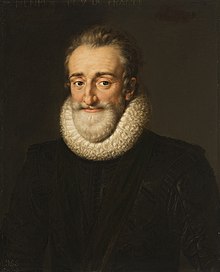 Portrait by Frans Pourbus, 1610 | |
| King of France | |
| Reign | 2 August 1589 – 14 May 1610 |
| Coronation | 27 February 1594 Chartres Cathedral |
| Predecessor | Henry III |
| Successor | Louis XIII |
| King of Navarre | |
| Reign | 9 June 1572 – 14 May 1610 |
| Predecessor | Jeanne III |
| Successor | Louis II |
| Born | 13 December 1553 Château de Pau, Béarn |
| Died | 14 May 1610 (aged 56) Palais du Louvre, Paris, France |
| Cause of death | Assassination |
| Burial | 1 July 1610 Basilica of St Denis, Paris, France |
| Spouses | |
| Issue |
|
| House | Bourbon |
| Father | Antoine of Navarre |
| Mother | Jeanne III of Navarre |
| Religion | Calvinism (1553–1593) Catholicism (1593–1610) |
| Signature |  |
Henry IV (French: Henri IV; 13 December 1553 – 14 May 1610), also known by the epithets Good King Henry or Henry the Great, was King of Navarre (as Henry III) from 1572 and King of France from 1589 to 1610. He was the first monarch of France from the House of Bourbon, a cadet branch of the Capetian dynasty. He pragmatically balanced the interests of the Catholic and Protestant parties in France as well as among the European states. He was assassinated in 1610 by a Catholic zealot, and was succeeded by his son Louis XIII.
Henry was baptised a Catholic but raised in the Protestant faith by his mother. He inherited the throne of Navarre in 1572 on his mother's death. As a Huguenot (Protestant), Henry was involved in the French Wars of Religion, barely escaping assassination in the St. Bartholomew's Day massacre. He later led Protestant forces against the French royal army. Henry inherited the throne of France in 1589 upon the death of Henry III. Henry IV initially kept the Protestant faith (the only French king to do so) and had to fight against the Catholic League, which refused to accept a Protestant monarch. After four years of military stalemate, Henry converted to Catholicism, reportedly saying, "Paris is well worth a mass." As a pragmatic politician he promulgated the Edict of Nantes (1598), which guaranteed religious liberties to Protestants, thereby effectively ending the French Wars of Religion.
An active ruler, Henry worked to regularise state finance, promote agriculture, eliminate corruption and encourage education. He began the first successful French colonization of the Americas. He promoted trade and industry, and prioritized the construction of roads, bridges, and canals to facilitate communication within France and strengthen the country's cohesion. These efforts stimulated economic growth and improved living standards.
While the Edict of Nantes brought religious peace to France, some hardline Catholics and Huguenots remained dissatisfied, leading to occasional outbreaks of violence and conspiracies. Henry IV also faced resistance from certain noble factions who opposed his centralization policies, leading to political instability.
His main foreign policy success was the Peace of Vervins in 1598, which made peace in the long-running conflict with Spain. He formed a strategic alliance with England. He also forged alliances with Protestant states, such as the Dutch Republic and several German states, to counter the Catholic powers. His policies contributed to the stability and prominence of France in European affairs.
|
Main article: Succession of Henry IV of France |


When Henry III died, his ninth cousin once removed, Henry of Navarre, nominally became king of France. The Catholic League, however, strengthened by foreign support—especially from Spain—was strong enough to prevent a universal recognition of his new title. Pope Sixtus V excommunicated Henry and declared him ineligible to inherit the crown.[11] Most of the Catholic nobles who had joined Henry III for the siege of Paris also refused to recognize Henry of Navarre, and abandoned him. He set about winning his kingdom by force of arms, aided by English money and German troops. Henry's Catholic uncle Charles, Cardinal de Bourbon was proclaimed king by the League, but the Cardinal was Henry's prisoner at the time.[12] Henry was victorious at the Battle of Arques and the Battle of Ivry, but failed to take Paris after besieging it in 1590.[13]

When Cardinal de Bourbon died in 1590, the League could not agree on a new candidate at the Estates General called to settle the question, also attended by the envoys of Spain. While some supported various Guise candidates, the strongest candidate was probably the Infanta Isabella Clara Eugenia of Spain, daughter of Philip II of Spain, whose mother Elisabeth had been the eldest daughter of Henry II of France.[14] In the religious fervor of the time, the Infanta was considered a suitable queen, provided she married a suitable husband. The French overwhelmingly rejected Philip's first choice, Archduke Ernest of Austria, the Emperor's brother, also a member of the House of Habsburg. In case of such opposition, Philip indicated that princes of the House of Lorraine would be acceptable to him: the Duke of Guise; a son of the Duke of Lorraine; and the son of the Duke of Mayenne. The Spanish ambassadors selected the Duke of Guise, to the joy of the League. However, at that moment of seeming victory, the envy of the Duke of Mayenne was aroused, and he blocked the proposed election of a king.
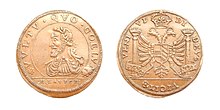
The Parlement of Paris also upheld the Salic law. They argued that if the French accepted natural hereditary succession, as proposed by the Spaniards, and accepted a woman as their queen, then the ancient claims of the English kings would be confirmed, and the monarchy of centuries past would be rendered illegal.[15] The Parlement admonished Mayenne, as lieutenant-general, that the kings of France had resisted the interference of the pope in political matters, and that he should not raise a foreign prince or princess to the throne of France under the pretext of religion. Mayenne was angered that he had not been consulted prior to this admonishment, but yielded, since their aim was not contrary to his present views.
Despite these setbacks for the League, Henry remained unable to take control of Paris.

On 25 July 1593, with the encouragement of his mistress, Gabrielle d'Estrées, Henry permanently renounced Protestantism and converted to Catholicism to secure his hold on the French crown,[16] thereby earning the resentment of the Huguenots and his ally Elizabeth I of England. He was said to have declared that Paris vaut bien une messe ("Paris is well worth a Mass"),[17][18][19] although the attribution is doubtful.[20][21] His acceptance of Catholicism secured the allegiance of the vast majority of his subjects.
Since Reims, traditional coronation place of French kings, was still occupied by the Catholic League, Henry was crowned King of France at the Cathedral of Chartres on 27 February 1594.[22] Pope Clement VIII lifted excommunication from Henry on 17 September 1595.[23] He did not forget his former Calvinist coreligionists, however, and was known for his religious tolerance. In 1598 he issued the Edict of Nantes, which granted circumscribed liberties to the Huguenots.[24]
Henry IV successfully ended the civil wars. He and his ministers appeased Catholic leaders using bribes of about 7 million écus, a sum greater than France's annual revenue. In combination with other fiscal problems, the king was faced with a financial crisis by the middle of the 1590s. In response to this crisis, Henry resolved to convene an Assembly of Notables in November 1596 that he hoped would approve the creation of new royal revenues.[25][26] The assembly approved the creation of a new tax on goods entering towns that would be known as the pancarte, however in 1597 the crown was again rocked by military crisis when the Spanish seized Amiens.[27][28][29][30]
Huguenot leaders were placated by the Edict of Nantes, which had four separate sections. The articles laid down the tolerance which would be accorded to the Huguenots including the exact places where worship may or may not take place, the recognition of three Protestant universities, and the allowance of Protestant synods. The king also issued two personal documents (called brevets) which recognized the Protestant establishment. The Edict of Nantes signed religious tolerance into law, and the brevets were an act of benevolence that created a Protestant state within France.[27]
Despite this, it would take years to restore law and order to France. The Edict was met by opposition from the parlements, which objected to the guarantees offered to Protestants. The Parlement de Rouen did not formally register the edict until 1609, although it begrudgingly observed its terms.[31]
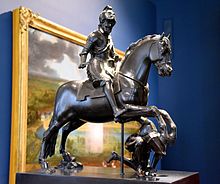
During his reign, Henry IV worked through the minister Maximilien de Béthune, Duke of Sully, to regularize state finance, promote agriculture, drain swamps, undertake public works, and encourage education. He established the Collège Royal Henri-le-Grand in La Flèche (today the Prytanée Militaire de la Flèche). He and Sully protected forests from further devastation, built a system of tree-lined highways, and constructed bridges and canals. He had a 1200-metre canal built in the park at the Château Fontainebleau (which may be fished today) and ordered the planting of pines, elms, and fruit trees.
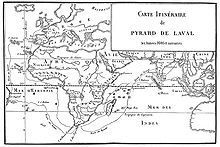
The King restored Paris as a great city, with the Pont Neuf, which still stands today, constructed over the river Seine to connect the Right and Left Banks of the city. Henry IV also built the Place Royale (known since 1800 as Place des Vosges), and added the Grande Galerie to the Louvre Palace. Stretching more than 400 metres along the Seine river bank, at the time it was the longest edifice of its kind in the world. He promoted the arts among all classes of people, and invited hundreds of artists and craftsmen to live and work on the building's lower floors. This tradition continued for another two hundred years, until ended by Napoleon I. The art and architecture of his reign have become known as the Henry IV style.
Economically, Henry IV sought to reduce imports of foreign goods to support domestic manufacturing. To this end, new sumptuary laws limited the use of imported gold and silver cloth. He also built royal factories to produce luxuries such as crystal glass, silk, satin, and tapestries (at Gobelins Manufactory and Savonnerie de Chaillot workshops). The king re-established silk weaving in Tours and Lyon, and increased linen production in Picardy and Brittany. He had distributed 16,000 free copies of the practical manual The Theatre of Agriculture by Olivier de Serres.[32]
King Henry's vision extended beyond France, and he financed several expeditions of Pierre Dugua, Sieur de Monts and Samuel de Champlain to North America.[33] France laid claim to New France (now Canada).[34]


During the reign of Henry IV, rivalry continued among France, Habsburg Spain, and the Holy Roman Empire for the mastery of Western Europe. The conflict was not resolved until after the Thirty Years' War.
|
Further information: French Wars of Religion § War with Spain (1595–1598) |
During Henry's struggle for the crown, Spain had been the principal backer of the Catholic League, and it tried to thwart Henry. Under the Duke of Parma, an army from the Spanish Netherlands intervened in 1590 against Henry and foiled his siege of Paris. Another Spanish army helped the Catholic League nobles opposing Henry to win the Battle of Craon in 1592.
The Spanish war was not ended with Henry's coronation, but after his victory at the Siege of Amiens in September 1597, the Peace of Vervins was signed in 1598. This freed his armies to settle the dispute with the Duchy of Savoy, ending with the Treaty of Lyon of 1601, which arranged territorial exchanges.
One of Henry's major problems was the Spanish Road which traversed Spanish territory through Savoy to the Low Countries. His first opportunity to cut the Spanish Road was a dispute over the ownership of the Marquisate of Saluzzo. The last marquis left Saluzzo to the French crown in 1548 (when Savoy was occupied by France), but the territory became disputed during the chaos of the Wars of Religion. The pope was asked to arbitrate between the claims of France and the Duke of Savoy. The Duke offered to cede Bresse to France if he could retain Saluzzo. Henri IV accepted this, but Spain objected that Bresse was a vital part of the Spanish Road, and persuaded the Duke to reject the decision. Henry IV was already at Lyon and had soldiers ready, and four days later he marched fifty thousand men against the duchy, occupying almost all of its area west of the Alps. In January 1601, Henry accepted another offer of papal arbitration and gained not only Bresse, but Bugey and Gex. Savoy retained a narrow corridor through the Val de Chézery. This still allowed Spanish troops to cross from Lombardy to Franche Comté without going through France, but it created a choke point where the Spanish Road was a single bridge across the Rhône River.[35]
The Saluzzo conflict was Henry IV's last major military operation, but he continued to finance Spain's enemies. He generously assisted the Dutch Republic with over 12 million livres between 1598 and 1610. In some years, the payment was 10% of France's total annual budget. France also sent subsidies to Geneva after the Duke of Savoy attempted to capture the city in 1602.[35]
In 1609 Henry helped negotiate an end to the War of the Jülich Succession.
It was widely believed that in 1610 Henry was preparing for war against the Holy Roman Empire, which was prevented by his assassination and the subsequent rapprochement with Spain under the regency of Marie de' Medici.

Even before Henry's accession to the French throne, the French Huguenots were in contact with Aragonese Moriscos in plans against the Habsburg government of Spain in the 1570s.[37] Around 1575, plans were made for a combined attack of Aragonese Moriscos and Huguenots from Béarn under Henry against Spanish Aragon, in agreement with the Dey of Algiers and the Ottoman Empire, but this project floundered with the arrival of John of Austria in Aragon and the disarmament of the Moriscos.[38][39] In 1576, a three-pronged Ottoman fleet from Constantinople was planned to disembark between Murcia and Valencia while the French Huguenots would invade from the north and the Moriscos accomplish their uprising, but the fleet failed to arrive.[38]
After his crowning, Henry continued the policy of a Franco-Ottoman alliance and received an embassy from Sultan Mehmed III in 1601.[40][41] In 1604, a "Peace Treaty and Capitulation" was signed between Henry IV and the Ottoman Sultan Ahmed I, granting France numerous advantages in the Ottoman Empire.[41]
In 1606–07, Henry IV sent Arnoult de Lisle as Ambassador to Morocco to request the observance of past friendship treaties. An embassy was sent to Ottoman Tunisia in 1608 led by François Savary de Brèves.[42]
|
Further information: France-Asia relations |
Under Henry IV, various enterprises were set up to develop long-distance trade. In December 1600, a company was formed through the association of Saint-Malo, Laval, and Vitré to trade with the Moluccas and Japan.[43] Two ships, the Croissant and the Corbin, were sent around the Cape of Good Hope in May 1601. The Corbin was wrecked in the Maldives, leading to the adventure of François Pyrard de Laval, who managed to return to France in 1611.[43][44] The Croissant, carrying François Martin de Vitré, reached Ceylon and traded with Aceh in Sumatra, but was captured by the Dutch on the return leg at Cape Finisterre.[43][44] François Martin de Vitré was the first Frenchman to write an account of travels to the Far East in 1604, at the request of Henry IV.[45]
From 1604 to 1609, following the return of François Martin de Vitré, Henry attempted to set up a French East India Company on the model of England and the Netherlands.[44][45][46] On 1 June 1604, he issued letters patent to Dieppe merchants to form the Dieppe Company, giving them exclusive rights to Asian trade for 15 years, but no ships were sent until 1616.[43] In 1609, another adventurer, Pierre-Olivier Malherbe, returned from a circumnavigation of the globe and informed Henry of his adventures.[45] He had visited China and India, and met with Emperor Akbar.[45]
Historians have assessed that Henry IV was a convinced Calvinist, and only changed his formal religious confession to achieve his political goals.
Henry IV was baptized as a Catholic on 5 January 1554. He was raised in the Reformed Tradition by his mother Jeanne III of Navarre. In 1572, after the massacre of French Calvinists, he was forced by Catherine de' Medici and the royal court to convert. In 1576, after escaping from Paris, he abjured Catholicism and returned to Calvinism. In 1593, to gain recognition as King of France, he converted again to Catholicism. Although a formal Catholic, he valued his Calvinist upbringing and was tolerant toward the Huguenots until his death in 1610, and issued the Edict of Nantes which granted them many concessions.

Henry was nicknamed Henri le Grand (the Great), and in France is also called le bon roi Henri (good king Henry) and le vert galant (The Green Gallant) for his numerous mistresses.[33][47] In English he is most often referred to as Henry of Navarre.
Though generally well-liked, Henry was considered a heretical usurper by some Catholics and a traitor to their faith by some Protestants.[48] Henry was the target of at least 12 assassination attempts, including by Pierre Barrière in August 1593[49] and by Jean Châtel in December 1594.[50]
Henry was killed in Paris on 14 May 1610 by François Ravaillac, a Catholic zealot who stabbed him while his coach was stopped on Rue de la Ferronnerie. The carriage was stopped by traffic congestion associated with the Queen's coronation ceremony, as depicted in the engraving by Gaspar Bouttats.[51][52] Hercule de Rohan, riding in the coach with the king, was wounded in the attack but survived. Ravaillac was immediately seized, and executed days later. Henry was buried at the Saint Denis Basilica.
His widow, Marie de' Medici, served as regent for their nine-year-old son, Louis XIII, until 1617.[53]


In 1614, four years after Henry IV's death, his statue was erected on the Pont Neuf. During the early phase of the French Revolution, when it aimed to create a constitutional monarchy rather than a republic, Henry IV was held up as a model for King Louis XVI. When the Revolution radicalized and came to reject monarchy altogether, Henry IV's statue was torn down along with other royal monuments. It was nevertheless the first to be rebuilt, in 1818, and it still stands on the Pont Neuf today.[54]
Henry IV was much lauded during the Bourbon Restoration, as the restored dynasty was keen to play down the controversial reigns of Louis XV and Louis XVI in favor of Good King Henry.[55] The song Marche Henri IV (Long Live Henry IV) was popular.[56] After the assassination of the dauphin Charles Ferdinand, Duke of Berry by a Republican fanatic, seven months later his widow Princess Caroline gave birth to their son, heir to the throne of France, and conspicuously named him Henri after his royal forefather. The boy was baptised with Jurançon wine and garlic in the tradition of Béarn and Navarre, as Henry IV had been baptised in Pau.[57]
Henry serves as a loose inspiration for the character Ferdinand, King of Navarre, in William Shakespeare's 1590s play Love's Labour's Lost.[58]

A 1661 biography, Histoire du Roy Henry le Grand,[59] was written by Hardouin de Péréfixe de Beaumont for the edification of Henry's grandson Louis XIV.[citation needed][60] A 1663 English translation was published for another grandson, King Charles II of England.[61]
On 14 September 1788, when anti-tax riots broke out during the incipient French Revolution, rioters stopped travellers and demanded they dismount to salute Henry IV's statue.[62]
Henry's minister Sully published his Royal Economies in 1611 after de Sully's fall from power, but subsequent research has shown that it exaggerates the economic accomplishments of Sully's ministry. Many of the official source documents were altered, or even forged to make them more impressive.[63]
|
Main article: Henry IV of France's succession |
| Ancestors of Henry IV of France[64] | |||||||||||||||||||||||||||||||||||||||||||||||||||||||||||||||||||||||||||||||||||||||||||||||||||||||||||||||||||||||||||||||||||||||||||||||||||||||||||||||||||||||||||||||||||||||||||||||||||||||||||||||||||||||||||||||||||||||||||||||||||||||||||||||||||||||||||||||||||||||||
|---|---|---|---|---|---|---|---|---|---|---|---|---|---|---|---|---|---|---|---|---|---|---|---|---|---|---|---|---|---|---|---|---|---|---|---|---|---|---|---|---|---|---|---|---|---|---|---|---|---|---|---|---|---|---|---|---|---|---|---|---|---|---|---|---|---|---|---|---|---|---|---|---|---|---|---|---|---|---|---|---|---|---|---|---|---|---|---|---|---|---|---|---|---|---|---|---|---|---|---|---|---|---|---|---|---|---|---|---|---|---|---|---|---|---|---|---|---|---|---|---|---|---|---|---|---|---|---|---|---|---|---|---|---|---|---|---|---|---|---|---|---|---|---|---|---|---|---|---|---|---|---|---|---|---|---|---|---|---|---|---|---|---|---|---|---|---|---|---|---|---|---|---|---|---|---|---|---|---|---|---|---|---|---|---|---|---|---|---|---|---|---|---|---|---|---|---|---|---|---|---|---|---|---|---|---|---|---|---|---|---|---|---|---|---|---|---|---|---|---|---|---|---|---|---|---|---|---|---|---|---|---|---|---|---|---|---|---|---|---|---|---|---|---|---|---|---|---|---|---|---|---|---|---|---|---|---|---|---|---|---|---|---|---|---|---|---|---|---|---|---|---|---|---|---|---|---|---|---|---|---|---|
| |||||||||||||||||||||||||||||||||||||||||||||||||||||||||||||||||||||||||||||||||||||||||||||||||||||||||||||||||||||||||||||||||||||||||||||||||||||||||||||||||||||||||||||||||||||||||||||||||||||||||||||||||||||||||||||||||||||||||||||||||||||||||||||||||||||||||||||||||||||||||
|
Main articles: Descendants of Henry IV of France and Henry IV of France's wives and mistresses |
On 18 August 1572, Henry married his second cousin Margaret of Valois. The marriage was not a happy one, and the couple was childless. Henry and Margaret separated even before Henry acceded to the throne in August 1589; Margaret retired to the Château d'Usson in the Auvergne and lived there for many years. After Henry became king of France, it was of the utmost importance that he provide an heir to the crown to avoid the problem of a disputed succession.
Henry favoured the idea of obtaining an annulment of his marriage to Margaret and marrying his mistress Gabrielle d'Estrées, who had already borne him three children. Henry's councillors strongly opposed this idea, but the matter was resolved unexpectedly by Gabrielle's sudden death in the early hours of 10 April 1599, after she had given birth to a premature stillborn son. His marriage to Margaret was annulled in 1599. On 17 December 1600, Henry married Marie de' Medici, daughter of Francesco I de' Medici, Grand Duke of Tuscany, and Archduchess Joanna of Austria.[65]
For the royal entry of Marie into Avignon on 19 November 1600, the citizens bestowed on Henry the title of the Hercule Gaulois ("Gallic Hercules"), concocting a genealogy that traced the House of Navarre back to a nephew of Hercules' son Hispalus.[66]
His marriage to Marie de' Medici produced six children:
| Name | Birth | Death | Notes |
|---|---|---|---|
| Louis XIII, King of France[67] | 27 September 1601 | 14 May 1643 | Married Anne of Austria in 1615 |
| Elisabeth, Queen of Spain | 22 November 1602 | 6 October 1644 | Married Philip IV, King of Spain, in 1615 |
| Christine Marie, Duchess of Savoy | 10 February 1606 | 27 December 1663 | Married Victor Amadeus I, Duke of Savoy, in 1619 |
| Monsieur d'Orléans | 16 April 1607 | 17 November 1611 | Never baptised or named; sometimes erroneously called "Nicolas." |
| Gaston, Duke of Orléans | 25 April 1608 | 2 February 1660 | Married (1) Marie de Bourbon, Duchess of Montpensier, in 1626 Married (2) Marguerite of Lorraine in 1632 |
| Henrietta Maria, Queen of England, Queen of Scots, and Queen of Ireland | 25 November 1609 | 10 September 1669 | Married Charles I, King of England, King of Scots and King of Ireland, in 1625 |
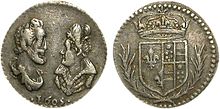
The arms of Henry IV changed throughout his lifetime: